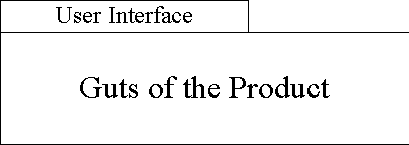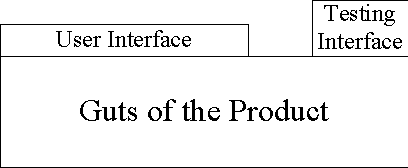主题三:人员问题
Fresh out of college, I got my first job as a tester. I had been hired as a developer, and knew nothing about testing, but, as they said, "we don't know enough about you yet, so we'll put you somewhere where you can't do too much damage". In due course, I "graduated" to development.
刚走出大学校门的时候,我得到了第一份工作:测试员。我是做为开发人员被录用的,对测试一无所知,但是他们说:“我们对你还不太了解,所以要把你放到一个你不能做太多破坏的地方。”在这个课程结束后,我“毕业”并加入到开发部门。
Using testing as a transitional job for new programmers is one of the two classic mistaken ways to staff a testing organization. It has some virtues. One is that you really can keep bad hires away from the code. A bozo in testing is often less dangerous than a bozo in development. Another is that the developer may learn something about testing that will be useful later. (In my case, it founded a career.) And it's a way for the new hire to learn the product while still doing some useful work.
将测试作为新程序员的过渡工作是组织测试人员架构的两个典型错误中的一个。这样做有一些可取之处。一是你的确可以使一些不合格的雇员远离代码。一个测试行业的笨蛋常常比一个开发行业的笨蛋的危险性要小。再有就是开发人员可能学习到一些以后有用的测试知识(就我而言,测试开创了我的职业生涯)。还有就是一个新手在了解产品的同时还能做一些有用的工作。
The advantages are outweighed by the disadvantage: the new hire can't wait to get out of testing. That's hardly conducive to good work. You could argue that the testers have to do good work to get "paroled". Unfortunately, because people tend to be as impressed by effort as by results, vigorous activity - especially activity that establishes credentials as a programmer - becomes the way out. As a result, the fledgling tester does things like become the expert in the local programmable editor or complicated freeware tool. That, at least, is a potentially useful role, though it has nothing to do with testing. More dangerous is vigorous but misdirected testing activity; namely, test automation. (See the last theme.)
但是不利之处超过了有利之处:新雇员迫不及待地要离开测试行业。这很难产生高质量的工作。你可能会争辩说测试员为了“被释放”,必定会好好工作。不幸的是,过程给人留下的印象常常像结果一样深刻,严厉的活动——特别是为了证实具备程序员资格的活动——变得过时了。结果,缺乏经验的测试员所做的事情就像一个局部可编程编辑器专家或是一个复杂的自由软件工具专家所做的事情一样。这些虽然与测试无关,但至少还有潜在的作用。更危险的是误导了测试活动,即测试自动化。(参见最后一个主题)
Even if novice testers were well guided, having
so much of the testing staff be transients could only work if testing
is a shallow algorithmic discipline. In fact, good testers require
deep knowledge and experience.
即使新测试员很好地获得指导,除非测试是一个浅显的算法学科,否则将这么多测试人员转换工作也是不可行的。事实上,好的测试员需要深入的知识与经验。
The second classic mistake is recruiting testers from the ranks of failed programmers. There are plenty of good testers who are not good programmers, but a bad programmer likely has some work habits that will make him a bad tester, too. For example, someone who makes lots of bugs because he's inattentive to detail will miss lots of bugs for the same reason.
第二个典型错误是从不合格的程序员中招募测试员。有很多好的测试员都不是好的程序员,但一个不好的程序员的一些工作习惯可能使他也会成为一个不好的测试员。例如,一个因为不注重细节的而产生很多bug的人也会因为同样的原因而漏掉很多bug。
So how should the testing team be staffed? If you're willing to be part of the training department, go ahead and accept new programmer hires. Accept as applicants programmers who you suspect are rejects (some fraction of them really have gotten tired of programming and want a change) but interview them as you would an outside hire. When interviewing, concentrate less on formal qualifications than on intelligence and the character of the candidate's thought. A good tester has these qualities:
那么应该如何招募测试团队呢?如果你愿意成为一个培训部门,可以继续接受一些新程序员。接受一些你怀疑是被其他人舍弃的程序员申请人(他们之中确实有一些人是厌倦了编程而想有一些变化),但是像从公司外面招人一样面试他们。在面试的时候,重点集中于应聘者的智力和思想特征而不是表面的资历。一个好测试员应该具备:
- methodical and systematic.
- 有条理、有计划。
- tactful and diplomatic (but firm when necessary).
- 有策略、说话办事得体(但在需要的时候要坚定)
- skeptical, especially about assumptions, and wants to see concrete evidence.
- 怀疑能力,特别是关于假设的,并要看到具体证明。
- able to notice and pursue odd details.
- 能够注意并跟踪奇怪的细节之处。
- good written and verbal skills (for explaining bugs clearly and concisely).
- 良好的书面和口头表达技巧(可以清楚、简洁地解释 bug )。
- a knack for anticipating what others are likely to misunderstand. (This is useful both in finding bugs and writing bug reports.)
- 能够预料到其他人可能会误解什么的能力(这在发现 bug 和编写 bug 报告时非常有用)
- a willingness to get one's hands dirty, to experiment, to try something to see what happens.
- 愿意不辞辛苦地进行实验,尝试一些事情来看看会发生什么。
Be especially careful to avoid the trap of testers who are not domain experts. Too often, the tester of an accounting package knows little about accounting. Consequently, she finds bugs that are unimportant to accountants and misses ones that are. Further, she writes bug reports that make serious bugs seem irrelevant. A programmer may not see past the unrepresentative test to the underlying important problem. (See the discussion of reporting bugs in the next theme.)
特别是要小心避免测试员不是领域专家的陷阱。经常地,会计软件包的测试员对会计了解很少。结果是,她发现的 bug 对于会计师来说不重要,但又漏掉了很多对于会计师来说很重要的 bug 。而且,她编写的 bug 报告将使严重的 bug 看起来无关紧要。程序员可能无法透过不具备代表性的测试来看到底层的重要问题(查看下一主题中的关于报告 bug 的讨论。)
Domain experts may be hard to find. Try to find a few. And hire testers who are quick studies and are good at understanding other people's work patterns.
领域专家可能不太好找。尝试去找几个。聘用那些能够快速学习并且善于理解他人工作方式的测试员。
Two groups of people are readily at hand and often have those skills. But testing teams often do not seek out applicants from the customer service staff or the technical writing staff. The people who field email or phone problem reports develop, if they're good, a sense of what matters to the customer (at least to the vocal customer) and the best are very quick on their mental feet.
有两组人员比较容易找并且常常具备这些技能。但是测试小组经常不从客户服务人员或技术文档写作人员中寻求申请人。通过邮件或电话解决问题报告的人,如果是称职的,那么他们知道对于客户(至少是电话中的客户)来说什么是重要、最好的,这种感觉对他们将有所帮助。
Like testers, technical writers often also lack detailed domain knowledge. However, they're in the business of translating a product's behavior into terms that make sense to a user. Good technical writers develop a sense of what's important, what's confusing, and so on. Those areas that are hard to explain are often fruitful sources of bugs. (What confuses the user often also confuses the programmer.)
像测试员一样,技术写作人员常常也缺乏详细的领域知识。但是,他们的工作是将产品的特性以对用户有意义的方式转换出来。一个好的技术写作人员有培养出一种什么是重要的、什么是令人迷惑的感觉。那些难于解释的领域经常包含了很多的测试错误。(使用户感到迷惑的地方同样也会使程序员感到迷惑。)
One reason these two groups are not tapped is an insistence that testers be able to program. Programming skill brings with it certain advantages in bug hunting. A programmer is more likely to find the number 2,147,483,648 interesting than an accountant will. (It overflows a signed integer on most machines.) But such tricks of the trade are easily learned by competent non-programmers, so not having them is a weak reason for turning someone down.
没有选择这两组人员的一个原因是坚持认为测试员都应当会编程。编程技巧会给搜寻 bug 带来一定的优势。与财务人员相比,程序员更有可能发现数字2,147,483,648是有趣的(这个数字在大多数机器的有符号整数中溢出。)但是这种技巧很容易被有能力的非程序员掌握,所以这是不录取他们的一个不充分的理由。
If you hire according to these guidelines, you will avoid a testing team that lacks diversity. All of the members will lack some skills, but the team as a whole will have them all. Over time, in a team with mutual respect, the non-programmers will pick up essential tidbits of programming knowledge, the programmers will pick up domain knowledge, and the people with a writing background will teach the others how to deconstruct documents.
如果你按照这些规则招聘员工,你就会避免一个缺乏多样性的测试小组。所有的成员都会缺乏某些技能,但作为一个整体,小组应当具备这些所有的技能。随着时间的推移,在一个互相尊重的的小组中,非程序员将获取一些最基础的编程知识,程序员将获得专业领域知识,而具有写作背景的人将教会其他人如何解构、拆析文档。
All testers - but non-programmers especially - will be hampered by a physical separation between developers and testers. A smooth working relationship between developers and testers is essential to efficient testing. Too much valuable information is unwritten; the tester finds it by talking to developers. Developers and testers must often work together in debugging; that's much harder to do remotely. Developers often dismiss bug reports too readily, but it's harder to do that to a tester you eat lunch with.
所有的测试员——尤其是非程序员——会被开发人员和测试员在物理位置上的隔离所困扰。开发人员和测试员之间和谐的工作关系对于有效测试来说至关重要。太多有价值的信息没有记录下来;测试员在与开发人员交谈时发现了它。开发人员与测试员必须在一起工作以排除 bug ,远程实现是非常困难的。开发人员常常随意关闭一个 bug 报告,但是对一个一起吃午餐的测试员的报告却很难这样做。
Remote testing can be made to work - I've done it - but you have to be careful. Budget money for frequent working visits, and pay attention to interpersonal issues.
远程测试也能达到目的——我就这样做过——但你必须很小心。经常进行工作访问的资金预算,并且要注意人际关系问题。
Some believe that programmers can't test their own code. On the face of it, this is false: programmers test their code all the time, and they do find bugs. Just not enough of them, which is why we need independent testers.
有些人相信程序员不能测试他们自己的代码。这显然不对:程序员一直都在测试他们的代码,而且他们也的确能够发现 bug 。只是发现的 bug 还不够多,这也是为什么我们需要独立的测试员。
But if independent testers are testing, and programmers are testing (and inspecting), isn't there a potential duplication of effort? And isn't that wasteful? I think the answer is yes. Ideally, programmers would concentrate on the types of bugs they can find adequately well, and independent testers would concentrate on the rest.
但是如果独立测试员也在测试,程序员也在测试(并且也在走查代码),其中不存在潜在的重复工作吗?这不是一种浪费吗?我想答案是肯定的。理想情况中,程序员应当集中于他们能够充分发现的 bug 类型,而独立测试员应集中于其他部分。
The bugs programmers can find well are those where their code does not do what they intended. For example, a reasonably trained, reasonably motivated programmer can do a perfectly fine job finding boundary conditions and checking whether each known equivalence class is handled. What programmers do poorly is discovering overlooked special cases (especially error cases), bugs due to the interaction of their code with other people's code (including system-wide properties like deadlocks and performance problems), and usability problems.
程序员能够较好地发现的 bug 是那些与他们预期不符的代码。例如,一个接受过一定培训、有一定积极性的程序员可以很好地找到边界条件,并且检查每一个等价类是否都处理了。程序员做的不好的地方是不能发现被忽略的某些情况(尤其是错误情况),不能发现由于他们的代码与其他人的代码交互作用而产生的 bug ,以及易用性问题。
Crudely put, good programmers do functional testing, and testers should do everything else. Recall that I earlier claimed an over-concentration on functional testing is a classic mistake. Decent programmer testing magnifies the damage it does.
大致来说,好的程序员进行功能测试,测试员应该完成其他所有工作。回忆一下我前面曾说过,过分集中于功能测试是一个典型错误。合格的程序员测试夸大了它产生的破坏。
Of course, decent programmer testing is relatively rare, because programmers are neither trained nor motivated to test. This is changing, gradually, as companies realize it's cheaper to have bugs found and fixed quickly by one person, instead of more slowly by two. Until then, testers must do both the testing that programmers can do and the testing only testers can do, but must take care not to let functional testing squeeze out the rest.
当然,合格的程序员测试相对较少,因为程序员既没有接受过培训,对测试也没有热情。但是随着各个公司意识到由一个人发现并修复 bug 成本较低,这种情况也在逐步改变。在此之前,测试员不但必须完成程序员可以完成的测试,还要完成只有测试员才能完成的工作,还必须小心不要让功能测试挤占了其他测试。
主题四:工作中的测试员
When testing, you must decide how to exercise the program, then do it. The doing is ever so much more interesting than the deciding. A tester's itch to start breaking the program is as strong as a programmer's itch to start writing code - and it has the same effect: design work is skimped, and quality suffers. Paying more attention to running tests than to designing them is a classic mistake. A tester who is not systematic, who does not spend time laying out the possibilities in advance, will overlook special cases. They may be the same subtle ones that the programmers overlooked.
在测试的时候,必须决定如何执行程序,然后完成它们。完成它们比决定它们要有趣的多。测试员渴望的是开始破坏程序,程序员渴望的是开始写代码——这导致相同结果:设计工作被忽略了,产品质量受到损害。将更多的注意力集中于运行测试而不是设计它们是一个典型错误。
Concentration on execution also results in unreviewed test designs. Just like programmers, testers can benefit from a second pair of eyes. Reviews of test designs needn't be as elaborate as product design reviews, but a short check of the testing approach and the resulting tests can find significant omissions at low cost.
集中于执行测试也导致未经审核的测试设计。就像程序员一样,测试员也得益于第二双眼睛的检查。测试设计的审核不必像产品审核那样严格,但是对测试方法和结果测试的快速检查可以低成本地找到重要的疏忽。
What is a test design?
什么是测试设计?
A test design should contain a description of the setup (including machine configuration for a configuration test), inputs given to the product, and a description of expected results. One common mistake is being too specific about test inputs and procedures.
测试设计应当包含设置描述(包括配置测试的机器配置),对产品的输入和预期结果的描述。一个常见错误是对测试输入和过程过于注重细节。
Let's assume manual test implementation for the moment. A related argument for automated tests will be discussed in the next section. Suppose you're testing a banking application. Here are two possible test designs:
让我们先假设一个手工测试实施。相关的自动化测试将在下一节讨论。假设你在测试银行应用程序。这里有两个可能的测试设计:
Design 1
设计1
Setup: initialize the balance in account 12 with $100.
设置:将帐户12的余额初始化为$100。
Procedure:
过程:
Start the program.
Type 12 in the Account window.
Press OK.
Click on the 'Withdraw' toolbar button.
In the withdraw popup dialog, click on the 'all' button.
Press OK.
Expect to see a confirmation popup that says "You are about to withdraw all the money from this account. Continue?"
Press OK.
Expect to see a 0 balance in the account window.
Separately query the database to check that the zero balance has been posted.
Exit the program with File->Exit.
启动程序。
在帐户窗口中输入12。
按“确定”按钮。
点击“取款”工具条按钮。
在弹出的取款对话框中,点击“所有”按钮。
按“确定”按钮。
预期会看到一个确认消息:“您将从此帐户中取出所有的钱,是否继续?”
按“确定”按钮。
在帐户窗口中预期会看到余额为0。
单独查询数据库,检查余额为0。
通过“文件->退出” 退出程序。
Design 2
设计2
Setup: initialize the balance with a positive value.
设置:将帐户余额初始化为一个正值。
Procedure:
过程:
Start the program on that account.
Withdraw all the money from the account using the 'all' button.
It's an error if the transaction happens without a confirmation popup.
Immediately thereafter:
- Expect a $0 balance to be displayed.
- Independently query the database to check that the zero balance has been posted.
启动该帐户的程序。
用“所有”按钮从帐户中取出所有的钱。
如果在事务发生时没有弹出确认消息,则是一个错误。
其后立即:
- 预期余额会显示$0。
- 单独查询数据库,检查余额为0。
The first design style has these advantages:
第一种设计风格有以下优点:
· The test will always be run the same way. You are more likely to be able to reproduce the bug. So will the programmer.
· 测试总是以相同方式运行。重现错误的可能性更大。程序员也一样。
· It details all the important expected results to check. Imprecise expected results make failures harder to notice. For example, a tester using the second style would find it easier to overlook a spelling error in the confirmation popup, or even that it was the wrong popup.
· 它将所有要检查的预期结果的细节都描述出来。不精确的预期结果使得错误更难注意到。例如,使用第二种风格的测试员将会发现更容易忽略确认对话框中的错误拼写,甚至是错误的对话框。
· Unlike the second style, you always know exactly what you've tested. In the second style, you couldn't be sure that you'd ever gotten to the Withdraw dialog via the toolbar. Maybe the menu was always used. Maybe the toolbar button doesn't work at all!
· 不像第二种测试风格,你总是能明确地知道你在测试什么。在第二种风格中,你不能确定可以通过工具条得到“取款”对话框。也许总是使用菜单。也许工具条根本不起作用!
· By spelling out all inputs, the first style prevents testers from carelessly overusing simple values. For example, a tester might always test accounts with $100, rather than using a variety of small and large balances. (Either style should include explicit tests for boundary and special values.)
· 通过写出所有的输入,第一种风格防止程序员无意间过度使用简单的值。例如,一个测试员可能总是用$100测试帐户,而不是使用一些小的和大的余额的组合。(这两种风格都应显式地包含边界值和特殊值测试。)
However, there are also some disadvantages:
但是,也有一些缺点:
· The first style is more expensive to create.
· 创建第一种风格的测试成本较高。
· The inevitable minor changes to the user interface will break it, so it's more expensive to maintain.
· 对用户界面的一些不可避免的更改将中断它,因此维护成本也就更高。
· Because each run of the test is exactly the same, there's no chance that a variation in procedure will stumble across a bug.
· 因为每一轮测试都完全相同,所以也就没有机会因为过程不同而偶然发现 bug 。
· It's hard for testers to follow a procedure exactly. When one makes a mistake - pushes the wrong button, for example - will she really start over?
· 测试员难于遵循测试过程。如果一个人出现错误——比如说按错按钮——她需要重新开始吗?
On balance, I believe the negatives often outweigh the positives, provided there is a separate testing task to check that all the menu items and toolbar buttons are hooked up. (Not only is a separate task more efficient, it's less error-prone. You're less likely to accidentally omit some buttons.)
如果能有一个独立的测试任务来检查所有的菜单项和工具条按钮都连接了代码(一个单独的测试不但更有效,而且不易出错。你不大会偶然地忽略掉一些按钮。),那么权衡利弊,我相信第一种设计的负面影响超过正面影响。
I do not mean to suggest that test cases should not be rigorous, only that they should be no more rigorous than is justified, and that we testers sometimes error on the side of uneconomical detail.
我不是认为测试用例不应当严格,只是说它们过分严格,而且我们测试员有时在不经济的细节中犯错误。
Detail in the expected results is less problematic than in the test procedure, but too much detail can focus the tester's attention too much on checking against the script he's following. That might encourage another classic mistake: not noticing and exploring "irrelevant" oddities. Good testers are masters at noticing "something funny" and acting on it. Perhaps there's a brief flicker in some toolbar button which, when investigated, reveals a crash. Perhaps an operation takes an oddly long time, which suggests to the attentive tester that increasing the size of an "irrelevant" dataset might cause the program to slow to a crawl. Good testing is a combination of following a script and using it as a jumping-off point for an exploration of the product.
详细的预期结果比详细的测试过程问题要少,但是过多的细节可能是测试员的注意力过多集中于检查他所依照的脚本。这可能也导致另一个典型错误:不能注意和探索“不相关的”奇怪现象。好的测试员善于注意到“有趣的东西”并对其进行操作。可能在工具条的一个短暂的闪动,经过调查后,揭示了一个失效错误。也许一个操作任务奇怪地花费了很长时间,可能使专注的程序员感到增加“不相关”的数据集合的大小可能使程序慢如蜗牛。好的测试是既遵循脚本,又能将它作为探索产品的出发点。
An important special case of overlooking bugs is checking that the product does what it's supposed to do, but not that it doesn't do what it isn't supposed to do. As an example, suppose you have a program that updates a health care service's database of family records. A test adds a second child to Dawn Marick's record. Almost all testers would check that, after the update, Dawn now has two children. Some testers - those who are clever, experienced, or subject matter experts - would check that Dawn Marick's spouse, Brian Marick, also now has two children. Relatively few testers would check that no one else in the database has had a child added. They would miss a bug where the programmer over-generalized and assumed that all "family information" updates should be applied both to a patient and to all members of her family, giving Paul Marick (aged 2) a child.
一个重要的忽略 bug的特例情况是检查产品完成预期操作,但不检查它是否没有完成不应该完成的操作。举个例子,假设你有一个更新医疗机构的家庭记录数据库的程序。一个测试是在Dawn Marick的记录中添加第二个小孩。几乎所有的测试员都将在更新之后检查Dawn Marick现在有两个小孩了。部分测试员——那些聪明的、有经验的专家——将会检查Dawn Marick的配偶——Brian Marick,现在也有两个小孩了。相对较少的测试员将检查数据库中没有其他人添加了小孩。如果程序员将规则过分扩展,认为应当对所有的既是病人又是她的家庭成员的人都更新 “家庭信息”,给了Paul Marick(2岁)一个小孩,则这个 bug 就被忽略了。
Ideally, every test should check that all data that should be modified has been modified and that all other data has been unchanged. With forethought, that can be built into automated tests. Complete checking may be impractical for manual tests, but occasional quick scans for data that might be corrupted can be valuable.
理想情况中,每个测试都应检查需要修改的数据都被修改了,其他数据都没有。在经过仔细考虑后,可以将这个过程构建到自动化测试中。完全检查可能对于手工测试来说不切合实际的,但是偶尔地快速检查数据是否破坏可能是很有价值的。
Testing should not be isolated work
测试不应当是孤立的工作
Here's another version of the test we've been discussing:
这里是我们讨论过的另一个版本:
Design 3
设计3
Withdraw all with confirmation and normal check for 0.
取出所有钱,需要确认,并检查余额为0。
That means the same thing as Design 2 - but only to the original author. Test suites that are understandable only by their owners are ubiquitous. They cause many problems when their owners leave the company; sometimes many month's worth of work has to be thrown out.
除了最初的作者,这与设计2是相同的。测试套件只有它们的作者才能理解是常见情况。当它们的拥有者离开公司后,会带来许多问题;有时候很多个月的工作就白费了。
I should note that designs as detailed as Designs 1 or 2 often suffer a similar problem. Although they can be run by anyone, not everyone can update them when the product's interface changes. Because the tests do not list their purposes explicitly, updates can easily make them test a little less than they used to. (Consider, for example, a suite of tests in the Design 1 style: how hard will it be to make sure that all the user interface controls are touched in the revised tests? Will the tester even know that's a goal of the suite?) Over time, this leads to what I call "test suite decay," in which a suite full of tests runs but no longer tests much of anything at all.
我需要说明的是像设计1和2那样详细的设计也存在同样的问题。虽然他们可能由任何人运行,但不是每个人都能在产品界面变化后更新它们。因为测试不会显式地列出它们的目的,更新它们可能很容易使得比以前测试的少一点点。(例如,考虑一下,设计1风格中的测试套件:要确保所有用户界面控件在更改后的测试中被涉及是一件多么困难的事情?)长期以来,这导致了我称为“测试套件变质”的问题,完整的测试套件仍旧在运行,但什么也测试不了。
Another classic mistake involves the boundary between the tester and programmer. Some products are mostly user interface; everything they do is visible on the screen. Other products are mostly internals; the user interface is a "thin pipe" that shows little of what happens inside. The problem is that testing has to use that thin pipe to discover failures. What if complicated internal processing produces only a "yes or no" answer? Any given test case could trigger many internal faults that, through sheer bad luck, don't produce the wrong answer.
另一个典型错误是测试员与程序员的边界。某些产品主要是用户界面;他们做的所有操作在屏幕上都是可见的。其他产品主要是内部的;用户界面是一个“细管道”,很少显示内部发生什么。问题是测试必须使用那个细管道来发现错误。如果一个复杂的内部处理产生的只是“是或否”的答案,结果会怎么样呢?任何给定的测试用例都能触发很多内部错误,仅仅通过不坏的运气,才不会产生错误的答案。
In such situations, testers sometimes rely solely on programmer ("unit") testing. In cases where that's not enough, testing only through the user-visible interface is a mistake. It is far better to get the programmers to add "testability hooks" or "testpoints" that reveal selected internal state. In essence, they convert a product like this:
在这样的情况中,有时候测试员单独依赖于程序员(“单元”) 测试。在这不够充足的情况下,仅从用户可见的界面测试是一个错误。如果使程序员加上“可测试性钩子”或“测试点”以揭示所选择的内部状态的话,会好得多。本质上,他们将一个产品:


to one like this:
转化为:


It is often difficult to convince programmers to add test support code to the product. (Actual quote: "I don't want to clutter up my code with testing crud.") Persevere, start modestly, and take advantage of these facts:
说服程序员向产品中添加测试支持代码常常是很困难的(一个真实引语:“我不想让测试代码弄乱我的程序。”)坚持下去,适时开始,并利用以下事实:
1. The test support code is often a simple extension of the debugging support code programmers write anyway.
测试支持代码常常只是程序员随便编写的调试支持程序的简单延伸。
2. A small amount of test support code often goes a long way.
少量的测试支持代码常常就会带来很大帮助。
A common objection to this approach is that the test support code must be compiled out of the final product (to avoid slowing it down). If so, tests that use the testing interface "aren't testing what we ship". It is true that some of the tests won't run on the final version, so you may miss bugs. But, without testability code, you'll miss bugs that don't reveal themselves through the user interface. It's a risk tradeoff, and I believe that adding test support code usually wins. See [Marick95], chapter 13, for more details.
对这种方法的普遍的反对意见是测试支持代码必须编译在最终产品之外(以避免显示)。如果是这样的,测试员使用的测试界面“不是我们交付的产品”。诚然,某些测试不会运行在最终版本中,所以可能会漏掉一些 bug 。但是,没有可测试的代码,你会漏掉一些通过用户界面无法揭示的 bug 。这是一个风险的权衡,我相信添加测试代码通常会占上风。参见[Marick95]的第13章以获取更多详细内容。
In one case, there's an alternative to having the programmer add code to the product: have a tool do it. Commercial tools like Purify, Boundschecker, and Sentinel automatically add code that checks for certain classes of failures (such as memory leaks). They provide a narrow, specialized testing interface. For marketing reasons, these tools are sold as programmer debugging tools, but they're equally test support tools, and I'm amazed that testing groups don't use them as a matter of course.
有一种情况是,有一个方案替代程序远向产品添加代码:用工具来完成。一些商用工具如Purify、Boundschecker和Sentinel可以自动添加代码以检查某种类型的错误(比如内存泄露)。它们提供一个狭小的、专用的测试界面。因为市场营销的原因,这些工具是作为程序员调试工具出售的,但它们等同于测试支持工具,测试小组没有把它们当成常规工具来使用,让我觉得很吃惊。
Testability problems are exacerbated in distributed systems like conventional client/server systems, multi-tiered client/server systems, Java applets that provide smart front-ends to web sites, and so forth. Too often, tests of such systems amount to shallow tests of the user interface component because that's the only component that the tester can easily control.
测试问题在分布式系统中,比如传统的客户/服务器系统、多层的客户/服务器系统、向站点提供灵巧的前端应用的Java小程序等,可测试性问题更为严重。常常地,测试这类系统等同于用户界面部件的浅显测试,因为它们是测试员能够容易控制的唯一部件。
Finding failures is only the start
发现错误仅仅是开始
It's not enough to find a failure; you must also report it. Unfortunately, poor bug reporting is a classic mistake. Tester bug reports suffer from five major problems:
发现错误是不够的,还必须报告它。不幸的是,低劣的 bug 报告是一个典型错误。测试员的错误报告存在五个主要问题:
1. They do not describe how to reproduce the bug. Either no procedure is given, or the given procedure doesn't work. Either case will likely get the bug report shelved.
他们没有描述如何重现 bug 。要么没有描述过程,要么描述的过程不正确。这两种情况都会使错误报告被搁置。
2. They don't explain what went wrong. At what point in the procedure does the bug occur? What should happen there? What actually happened?
他们没有解释出了什么问题。在什么地方出现了 bug ?将会发生什么?实际上又发生了什么?
3. They are not persuasive about the priority of the bug. Your job is to have the seriousness of the bug accurately assessed. There's a natural tendency for programmers and managers to rate bugs as less serious than they are. If you believe a bug is serious, explain why a customer would view it the way you do. If you found the bug with an odd case, take the time to reproduce it with a more obviously common or compelling case.
3. 关于 bug 的级别没有说服力。你的工作是评估 bug 的严重性。对于程序员和经理有一种很自然的倾向:评估的严重性比实际的严重性低。如果你确信一个 bug 是严重的,要解释一下为什么客户要以你的方式看待这个问题。如果你发现一个奇怪的错误,花一些时间以更普通、更令人信服的方式重现它。
4. They do not help the programmer in debugging. This is a simple cost/benefit tradeoff. A small amount of time spent simplifying the procedure for reproducing the bug or exploring the various ways it could occur may save a great deal of programmer time.
他们不能帮助程序员排除 bug 。这是一个简单的成本/收益权衡。花一点时间简化重现 bug 的过程或探索一下各种发生它的方法可以节约程序员大量的时间。
5. They are insulting, so they poison the relationship between developers and testers.
它们是侮辱性的,破坏了开发人员和测试人员的关系。
[Kaner93] has an excellent chapter (5) on how to write bug reports. Read it.
[Kaner93]有一章(第5章)非常好的内容说明了应该如何写 bug 报告。可以读一下。
Not all bug reports come from testers. Some come from customers. When that happens, it's common for a tester to write a regression test that reproduces the bug in the broken version of the product. When the bug is fixed, that test is used to check that it was fixed correctly.
不是所有的 bug 报告都是测试员写的。有一些是来自客户的。如果出现这样的情况,常见情况是测试员编写一个回归测试,在产品出现问题的版本上重现这个 bug 。如果 bug 得到修复,这个测试可以用于检查它是否正确修复。
However, adding only regression tests is not enough. A customer bug report suggests two things:
但是,仅仅添加回归测试是不够的。客户 bug 报告暗示着两个东西:
1. That area of the product is buggy. It's well known that bugs tend to cluster.
产品的那个领域包含了 bug。大家都知道, bug 一般是集中出现的。
2. That area of the product was inadequately tested. Otherwise, why did the bug originally escape testing?
产品的那个领域没有进行充分测试。否则的话,为什么开始测试的时候漏掉了那个 bug ?
An appropriate response to several customer bug reports in an area is to schedule more thorough testing for that area. Begin by examining the current tests (if they're understandable) to determine their systematic weaknesses.
对于某个领域中的几个客户 bug 报告的适当响应是对该领域安排一个更全面的测试。首先检查当前测试(如果它们是可以理解的话)以确定在系统性方面的不足之处。
Finally, every bug report is a gift from a customer that tells you how to test better in the future. A common mistake is failing to take notes for the next testing effort. The next product will be somewhat like this one, the bugs will be somewhat like these, and the tests useful in finding those bugs will also be somewhat like the ones you just ran. Mental notes are easy to forget, and they're hard to hand to a new tester. Writing is a wonderful human invention: use it. Both [Kaner93] and [Marick95] describe formats for archiving test information, and both contain general-purpose examples.
总之,每个 bug 报告都是客户的礼物,告诉我们在今后如何更好地测试。一个常见错误是不能为下次测试工作做好记录。下一个产品将在某种程度上类似于这一个, bug 在某种程度上类似于这一个,你刚才所做的测试在某种程度上类似于将来找出那些错误的测试。脑海中的记录容易忘记,也很难传授给新测试员。书写是人类一个美妙的发明:使用它。[Kaner93]和[Marick95]都描述了归档测试信息的格式,并包含了通用的示例。
-----------------------------------------------------------------------------------------
转自:http://www.uml.org.cn/Test/200709289.asp
